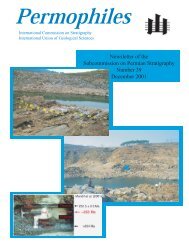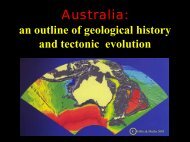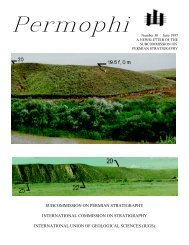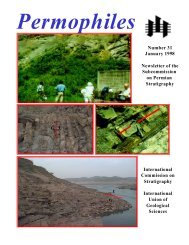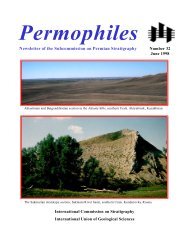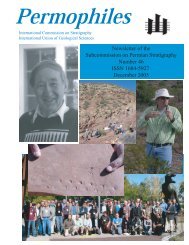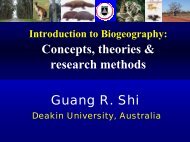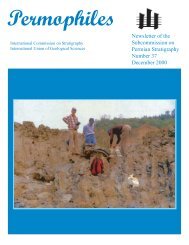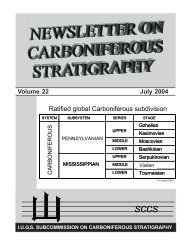SUBMISSION GUIDELINESFOR ISSUE 39It is best to submit manuscripts as attachments to E-mail messages.Please send messages and manuscripts to my E-mail addressfollowed by hard copies by regular mail. Please <strong>on</strong>ly send asingle versi<strong>on</strong> by E-mail and in <str<strong>on</strong>g>the</str<strong>on</strong>g> mail; if you discover correcti<strong>on</strong>sbefore <str<strong>on</strong>g>the</str<strong>on</strong>g> deadline, <str<strong>on</strong>g>the</str<strong>on</strong>g>n you may resubmit, but indicate <str<strong>on</strong>g>the</str<strong>on</strong>g>file name <str<strong>on</strong>g>of</str<strong>on</strong>g> <str<strong>on</strong>g>the</str<strong>on</strong>g> previous versi<strong>on</strong> that should be deleted. Manuscriptsmay also be sent to <str<strong>on</strong>g>the</str<strong>on</strong>g> address below <strong>on</strong> diskettes (3.5” orzip disks) prepared with a recent versi<strong>on</strong> <str<strong>on</strong>g>of</str<strong>on</strong>g> WordPerfect orMicros<str<strong>on</strong>g>of</str<strong>on</strong>g>t Word; printed hard copies should accompany <str<strong>on</strong>g>the</str<strong>on</strong>g> diskettes.Word processing files should have no pers<strong>on</strong>alized f<strong>on</strong>tsor o<str<strong>on</strong>g>the</str<strong>on</strong>g>r code and should be prepared in single column format.Specific and generic names should be italicized. Please refer torecent issues <str<strong>on</strong>g>of</str<strong>on</strong>g> Permophiles (Glenister et al., Permophiles #34, p.3) for reference style, format, etc. Maps and o<str<strong>on</strong>g>the</str<strong>on</strong>g>r illustrati<strong>on</strong>s areacceptable in tif, jpeg, eps, bitmap format or as CorelDraw files.The preferred formats for Adobe Pagemaker are Micros<str<strong>on</strong>g>of</str<strong>on</strong>g>t Worddocuments and tif files for images. We use Times Roman 12 pt.bold for title and author and 10 pt. for text. Indents for paragraphsare .2”. Word processing documents may include figures embeddedat <str<strong>on</strong>g>the</str<strong>on</strong>g> end <str<strong>on</strong>g>of</str<strong>on</strong>g> <str<strong>on</strong>g>the</str<strong>on</strong>g> text, but <str<strong>on</strong>g>the</str<strong>on</strong>g>se figures should also be attachedas separate attachments in tif format or as CorelDraw or AdobeIllustrator files. Do not include figure capti<strong>on</strong>s as part <str<strong>on</strong>g>of</str<strong>on</strong>g> <str<strong>on</strong>g>the</str<strong>on</strong>g> image;include <str<strong>on</strong>g>the</str<strong>on</strong>g> capti<strong>on</strong>s as a separate secti<strong>on</strong> within <str<strong>on</strong>g>the</str<strong>on</strong>g> text porti<strong>on</strong> <str<strong>on</strong>g>of</str<strong>on</strong>g><str<strong>on</strong>g>the</str<strong>on</strong>g> document. If <strong>on</strong>ly hard copies are sent, <str<strong>on</strong>g>the</str<strong>on</strong>g>se must be cameraready,i.e., clean copies, ready for publicati<strong>on</strong>. Typewritten c<strong>on</strong>tributi<strong>on</strong>smay be submitted by mail as clean paper copies; <str<strong>on</strong>g>the</str<strong>on</strong>g>semust arrive well ahead <str<strong>on</strong>g>of</str<strong>on</strong>g> <str<strong>on</strong>g>the</str<strong>on</strong>g> deadline, as <str<strong>on</strong>g>the</str<strong>on</strong>g>y require greater processingtime. Any versi<strong>on</strong>s that require translati<strong>on</strong> must also besubmitted well ahead <str<strong>on</strong>g>of</str<strong>on</strong>g> <str<strong>on</strong>g>the</str<strong>on</strong>g> deadline. All paper versi<strong>on</strong>s <str<strong>on</strong>g>of</str<strong>on</strong>g> articlesfor Permophiles will be destroyed after <str<strong>on</strong>g>the</str<strong>on</strong>g> deadline <str<strong>on</strong>g>of</str<strong>on</strong>g> <str<strong>on</strong>g>the</str<strong>on</strong>g> subsequentissue, unless a request is made for return.Please note that articles with names <str<strong>on</strong>g>of</str<strong>on</strong>g> new taxa will not be publishedin Permophiles. Readers are asked to refer to <str<strong>on</strong>g>the</str<strong>on</strong>g> rules <str<strong>on</strong>g>of</str<strong>on</strong>g> <str<strong>on</strong>g>the</str<strong>on</strong>g>ICZN. All manuscripts will be edited for c<strong>on</strong>sistent use <str<strong>on</strong>g>of</str<strong>on</strong>g> English<strong>on</strong>ly.I currently use a Windows 2000 PC with Corel Word Perfect 10,Corel Draw 10, Adobe Page Maker 6.5, Adobe Illustrator 9, andMicros<str<strong>on</strong>g>of</str<strong>on</strong>g>t Office 2000 programs; documents compatible with <str<strong>on</strong>g>the</str<strong>on</strong>g>sespecificati<strong>on</strong>s will be easiest to work with.E-Mail:henders<strong>on</strong>@geo.ucalgary.caMailing Address:Dr. Charles M. Henders<strong>on</strong>Department <str<strong>on</strong>g>of</str<strong>on</strong>g> Geology and GeophysicsUniversity <str<strong>on</strong>g>of</str<strong>on</strong>g> Calgary, Calgary, AlbertaCANADA T2N 1N4SUBMISSION DEADLINE FORISSUE 39 IS FEBRUARY 18, 2002This will be a firm deadline.Permophiles Issue #38 20012Report <str<strong>on</strong>g>of</str<strong>on</strong>g> <str<strong>on</strong>g>the</str<strong>on</strong>g> Working Group ”The C<strong>on</strong>tinentalSequences <str<strong>on</strong>g>of</str<strong>on</strong>g> <str<strong>on</strong>g>the</str<strong>on</strong>g> <strong>Permian</strong>”Vladlen R. LozovskyGeological Prospecting InstituteMiklucho-Maklay Str.23Moscow 117873 RussiaChair <str<strong>on</strong>g>of</str<strong>on</strong>g> Regi<strong>on</strong>al Geology & Palae<strong>on</strong>tologye-mail vlozovsky@mtu-net.ruJoerg W. SchneiderFreiberg University <str<strong>on</strong>g>of</str<strong>on</strong>g> Mining and TechnologyInstitute <str<strong>on</strong>g>of</str<strong>on</strong>g> GeologyDepartment <str<strong>on</strong>g>of</str<strong>on</strong>g> Palae<strong>on</strong>tologyBernhard-v<strong>on</strong>-Cotta Str.2Fax. (49) 03731 - 39-3599Ph<strong>on</strong>e (49) 03731 - 39-2856e-mail schneidj@geo.tu-freiberg.dewww: www.geo.tu-freiberg.de/~schneidjGiuseppe CassinisPavia University,Dipartimento di Scienze della TerraVia Ferrata 1,I-27100 Pavia, Italye-mail cassinis@unipv.itSince our last report, <str<strong>on</strong>g>the</str<strong>on</strong>g> highlights are firstly <str<strong>on</strong>g>the</str<strong>on</strong>g> field workshop<strong>on</strong> <str<strong>on</strong>g>the</str<strong>on</strong>g> late Paleozoic basins in Morocco, organized by <str<strong>on</strong>g>the</str<strong>on</strong>g>very active French ”Associati<strong>on</strong> des Géologues du Permien” incooperati<strong>on</strong> with <str<strong>on</strong>g>the</str<strong>on</strong>g> universities <str<strong>on</strong>g>of</str<strong>on</strong>g> Marrakech and Rabat as wellas <str<strong>on</strong>g>the</str<strong>on</strong>g> ”Groupe Marocain du Permien et du Trias”, and sec<strong>on</strong>dly<str<strong>on</strong>g>the</str<strong>on</strong>g> Internati<strong>on</strong>al C<strong>on</strong>gress <strong>on</strong> <str<strong>on</strong>g>the</str<strong>on</strong>g> ”Stratigraphic and structuralevoluti<strong>on</strong> <str<strong>on</strong>g>of</str<strong>on</strong>g> <str<strong>on</strong>g>the</str<strong>on</strong>g> Late Carb<strong>on</strong>iferous to Triassic C<strong>on</strong>tinental andMarine Successi<strong>on</strong>s in Tuscany (Italy); Regi<strong>on</strong>al Reports andGeneral Correlati<strong>on</strong>”. The latter was optimally organized by <str<strong>on</strong>g>the</str<strong>on</strong>g>Dipartimento di Scienze della Terra, Siena University, Italy. A summaryfollows below.After a general outline by G. Stampfli <strong>on</strong> <str<strong>on</strong>g>the</str<strong>on</strong>g> plate tect<strong>on</strong>ics <str<strong>on</strong>g>of</str<strong>on</strong>g><str<strong>on</strong>g>the</str<strong>on</strong>g> Western Tethys, a number <str<strong>on</strong>g>of</str<strong>on</strong>g> c<strong>on</strong>tributi<strong>on</strong>s about <str<strong>on</strong>g>the</str<strong>on</strong>g> LatePaleozoic to Triassic successi<strong>on</strong>s and events <str<strong>on</strong>g>of</str<strong>on</strong>g> Italy, and o<str<strong>on</strong>g>the</str<strong>on</strong>g>rEuropean and n<strong>on</strong>-European regi<strong>on</strong>s were given. In particular,am<strong>on</strong>g <str<strong>on</strong>g>the</str<strong>on</strong>g> latter, Pascucci & Gibling highlighted that Acadianterrane boundaries and o<str<strong>on</strong>g>the</str<strong>on</strong>g>r lineaments were reactivated in EasternCanada during a compressive tect<strong>on</strong>ic episode, probably during<str<strong>on</strong>g>the</str<strong>on</strong>g> <strong>Permian</strong>; rifting associated with <str<strong>on</strong>g>the</str<strong>on</strong>g> breakup <str<strong>on</strong>g>of</str<strong>on</strong>g> Pangeacommenced in Late <strong>Permian</strong> to Triassic times, resulting in a suite <str<strong>on</strong>g>of</str<strong>on</strong>g>extensi<strong>on</strong>al basins al<strong>on</strong>g <str<strong>on</strong>g>the</str<strong>on</strong>g> c<strong>on</strong>tinental margin south <str<strong>on</strong>g>of</str<strong>on</strong>g> <str<strong>on</strong>g>the</str<strong>on</strong>g> MaritimeBasin. Fur<str<strong>on</strong>g>the</str<strong>on</strong>g>rmore, <str<strong>on</strong>g>the</str<strong>on</strong>g> palynological assemblages recordedin <str<strong>on</strong>g>the</str<strong>on</strong>g> Sverdrup Basin have been compared by Spina, Cirilli & Baudwith those documented in <str<strong>on</strong>g>the</str<strong>on</strong>g> literature from some independentlydated P/T successi<strong>on</strong>s in <str<strong>on</strong>g>the</str<strong>on</strong>g> Boreal Domain and in o<str<strong>on</strong>g>the</str<strong>on</strong>g>r territories(e.g. Europe, East China, Pakistan). By this correlati<strong>on</strong> <str<strong>on</strong>g>the</str<strong>on</strong>g>following results can be stressed: 1) <str<strong>on</strong>g>the</str<strong>on</strong>g> range <str<strong>on</strong>g>of</str<strong>on</strong>g> some sporomorphsc<strong>on</strong>sidered as exclusively Early Triassic forms, am<strong>on</strong>g whichEndosporites papillatus, L. brevicula, D. nejburgii, must be extendeddownward to <str<strong>on</strong>g>the</str<strong>on</strong>g> uppermost <strong>Permian</strong>, and 2) <str<strong>on</strong>g>the</str<strong>on</strong>g> bloom and<str<strong>on</strong>g>the</str<strong>on</strong>g> differentati<strong>on</strong> <str<strong>on</strong>g>of</str<strong>on</strong>g> cavate spores in assemblages with acavate
key species occur close to <str<strong>on</strong>g>the</str<strong>on</strong>g> FAD <str<strong>on</strong>g>of</str<strong>on</strong>g> Hindeodus parvus, that is<str<strong>on</strong>g>the</str<strong>on</strong>g> newly adopted base <str<strong>on</strong>g>of</str<strong>on</strong>g> <str<strong>on</strong>g>the</str<strong>on</strong>g> Triassic.In Italy, research dealt with Carb<strong>on</strong>iferous to Triassic c<strong>on</strong>tinentaland locally marine deposits. In Sou<str<strong>on</strong>g>the</str<strong>on</strong>g>rn Tuscany, outcropswere intensively investigated, due to <str<strong>on</strong>g>the</str<strong>on</strong>g> complicated palaeogeographicaland structural framework <str<strong>on</strong>g>of</str<strong>on</strong>g> <str<strong>on</strong>g>the</str<strong>on</strong>g> regi<strong>on</strong>. Aldinucciemphasized a Carnian transgressi<strong>on</strong> in <str<strong>on</strong>g>the</str<strong>on</strong>g> Verrucano Group <str<strong>on</strong>g>of</str<strong>on</strong>g> <str<strong>on</strong>g>the</str<strong>on</strong>g>M<strong>on</strong>ticiano-Roccastrada Ridge, and with o<str<strong>on</strong>g>the</str<strong>on</strong>g>r c<strong>on</strong>tributors from<str<strong>on</strong>g>the</str<strong>on</strong>g> Siena and Florence universities also focussed <strong>on</strong> <str<strong>on</strong>g>the</str<strong>on</strong>g> lowermostCivitella Formati<strong>on</strong>. On <str<strong>on</strong>g>the</str<strong>on</strong>g> basis <str<strong>on</strong>g>of</str<strong>on</strong>g> general research carried out bySpina, Cirilli, Decandia & Lazzarotto, palynological data from <str<strong>on</strong>g>the</str<strong>on</strong>g>Poggio al Carpino Sandst<strong>on</strong>es in <str<strong>on</strong>g>the</str<strong>on</strong>g> M<strong>on</strong>ticiano area exhibitedEndosporites papillatus, Densoisporites spp., Lundbladisporaspp. and o<str<strong>on</strong>g>the</str<strong>on</strong>g>r forms, al<strong>on</strong>g with marine acritarchs (Michrystridiumspp. and Veryhachium spp.). According to Cirilli et al. (2001), <str<strong>on</strong>g>the</str<strong>on</strong>g>micr<str<strong>on</strong>g>of</str<strong>on</strong>g>loral assemblages show analogies with those found in <str<strong>on</strong>g>the</str<strong>on</strong>g>Mt. Argentario Sandst<strong>on</strong>es and <str<strong>on</strong>g>the</str<strong>on</strong>g>y are referable to <str<strong>on</strong>g>the</str<strong>on</strong>g> Late<strong>Permian</strong>-Early Triassic time interval. This interpretati<strong>on</strong> providesLazzarotto et al. with <str<strong>on</strong>g>the</str<strong>on</strong>g> basis for an original hypo<str<strong>on</strong>g>the</str<strong>on</strong>g>sis <strong>on</strong> <str<strong>on</strong>g>the</str<strong>on</strong>g>significance <str<strong>on</strong>g>of</str<strong>on</strong>g> <str<strong>on</strong>g>the</str<strong>on</strong>g> Tuscan Palaeozoic formati<strong>on</strong>s within <str<strong>on</strong>g>the</str<strong>on</strong>g> paleogeographicalframework <str<strong>on</strong>g>of</str<strong>on</strong>g> <str<strong>on</strong>g>the</str<strong>on</strong>g> future Western Mediterranean domainduring Carb<strong>on</strong>iferous time. The M<strong>on</strong>ticiano-Roccastradastratigraphical-structural Unit (from Mt. Argentario to Iano village,i.e. to <str<strong>on</strong>g>the</str<strong>on</strong>g> nor<str<strong>on</strong>g>the</str<strong>on</strong>g>rn extremity <str<strong>on</strong>g>of</str<strong>on</strong>g> <str<strong>on</strong>g>the</str<strong>on</strong>g> Mid-Tuscan Ridge), can befur<str<strong>on</strong>g>the</str<strong>on</strong>g>r subdivided into two main tect<strong>on</strong>ic slices stacked al<strong>on</strong>g alow-angle thrust. The Paleozoic porti<strong>on</strong>s <str<strong>on</strong>g>of</str<strong>on</strong>g> both <str<strong>on</strong>g>the</str<strong>on</strong>g>se subunits, <str<strong>on</strong>g>of</str<strong>on</strong>g>which <str<strong>on</strong>g>the</str<strong>on</strong>g> sec<strong>on</strong>d <strong>on</strong>e crops out <strong>on</strong>ly to <str<strong>on</strong>g>the</str<strong>on</strong>g> east in <str<strong>on</strong>g>the</str<strong>on</strong>g> Farmatorrent and <str<strong>on</strong>g>the</str<strong>on</strong>g> M<strong>on</strong>tagnola Senese, show remarkable differences,in c<strong>on</strong>trast with <str<strong>on</strong>g>the</str<strong>on</strong>g> uniform Middle-Upper Triassic part. Accordingto <str<strong>on</strong>g>the</str<strong>on</strong>g> authors <str<strong>on</strong>g>of</str<strong>on</strong>g> this presentati<strong>on</strong>, <str<strong>on</strong>g>the</str<strong>on</strong>g> Paleozoic formati<strong>on</strong>s <str<strong>on</strong>g>of</str<strong>on</strong>g>Sou<str<strong>on</strong>g>the</str<strong>on</strong>g>rn Tuscany were deposited within an evolving belt-foredeepforelandsystem. In <str<strong>on</strong>g>the</str<strong>on</strong>g> framework <str<strong>on</strong>g>of</str<strong>on</strong>g> this evoluti<strong>on</strong>ary scenario,<str<strong>on</strong>g>the</str<strong>on</strong>g> sou<str<strong>on</strong>g>the</str<strong>on</strong>g>rn boundary <str<strong>on</strong>g>of</str<strong>on</strong>g> Paleozoic c<strong>on</strong>tracti<strong>on</strong>al deformati<strong>on</strong>would represent <str<strong>on</strong>g>the</str<strong>on</strong>g> fr<strong>on</strong>t <str<strong>on</strong>g>of</str<strong>on</strong>g> <str<strong>on</strong>g>the</str<strong>on</strong>g> Hercynian belt during Early-MiddleCarb<strong>on</strong>iferous time, whereas <str<strong>on</strong>g>the</str<strong>on</strong>g> Farma flysch could have beendeposited in an adjacent, foredeep flexural basin. The Farma,Apuane and Elba areas were also subject to specific investigati<strong>on</strong>sby o<str<strong>on</strong>g>the</str<strong>on</strong>g>r authors. In Sou<str<strong>on</strong>g>the</str<strong>on</strong>g>rn Calabria, an exhumati<strong>on</strong> path <str<strong>on</strong>g>of</str<strong>on</strong>g> alate-Carb<strong>on</strong>iferous granitoid near Stilo was carefully examined byFesta et al.Sardinia was <str<strong>on</strong>g>the</str<strong>on</strong>g> topic <str<strong>on</strong>g>of</str<strong>on</strong>g> a detailed sedimentologic andlithostratigraphic analysis <str<strong>on</strong>g>of</str<strong>on</strong>g> <str<strong>on</strong>g>the</str<strong>on</strong>g> Late Carb<strong>on</strong>iferous S. Giorgio Basin(Sulcis), and a general revisi<strong>on</strong> <str<strong>on</strong>g>of</str<strong>on</strong>g> <str<strong>on</strong>g>the</str<strong>on</strong>g> Triassic deposits croppingout <strong>on</strong> <str<strong>on</strong>g>the</str<strong>on</strong>g> island (Barca & Costamagna). Cassinis, Cortesogno,Gaggero & R<strong>on</strong>chi focussed <strong>on</strong> <str<strong>on</strong>g>the</str<strong>on</strong>g> depositi<strong>on</strong>al history and <str<strong>on</strong>g>the</str<strong>on</strong>g>very interesting volcano-tect<strong>on</strong>ic evoluti<strong>on</strong> <str<strong>on</strong>g>of</str<strong>on</strong>g> <str<strong>on</strong>g>the</str<strong>on</strong>g> Early <strong>Permian</strong>Seui Basin (Barbagia). Traversa et al. emphasized <str<strong>on</strong>g>the</str<strong>on</strong>g> transiti<strong>on</strong>from orogenic calcalkaline to anorogenic alkaline magmatism in <str<strong>on</strong>g>the</str<strong>on</strong>g>late to post-Hercynian dyke activity <str<strong>on</strong>g>of</str<strong>on</strong>g> Sardinia-Corsica.Stratigraphical correlati<strong>on</strong>s and palaeogeographical rec<strong>on</strong>structi<strong>on</strong>sbetween <str<strong>on</strong>g>the</str<strong>on</strong>g> <strong>Permian</strong>-Triassic c<strong>on</strong>tinental successi<strong>on</strong>s <str<strong>on</strong>g>of</str<strong>on</strong>g> NorthwestSardinia (Nurra) and Sou<str<strong>on</strong>g>the</str<strong>on</strong>g>ast Provence (Toul<strong>on</strong>-Cuers) havealso been depicted by Cassinis, Durand & R<strong>on</strong>chi.In <str<strong>on</strong>g>the</str<strong>on</strong>g> Sou<str<strong>on</strong>g>the</str<strong>on</strong>g>rn Alps, Sciunnach points to a short durati<strong>on</strong>marine transgressi<strong>on</strong> in <str<strong>on</strong>g>the</str<strong>on</strong>g> Early <strong>Permian</strong> c<strong>on</strong>tinental Collio Basin<str<strong>on</strong>g>of</str<strong>on</strong>g> western Orobic chain. Rare calcareous foraminifers (Miliolacea)were found in a single sandst<strong>on</strong>e interval that also c<strong>on</strong>tainied phosphatenodules; <str<strong>on</strong>g>the</str<strong>on</strong>g> unit underlies by 30 m <str<strong>on</strong>g>the</str<strong>on</strong>g> angular unc<strong>on</strong>formitybetween <str<strong>on</strong>g>the</str<strong>on</strong>g> Collio Formati<strong>on</strong> and <str<strong>on</strong>g>the</str<strong>on</strong>g> superposed Upper <strong>Permian</strong>Permophiles Issue #38 20013red beds (Verrucano Lombardo). According to <str<strong>on</strong>g>the</str<strong>on</strong>g> author, this discoveryimplies that 1) <str<strong>on</strong>g>the</str<strong>on</strong>g> late Collio lake was not <strong>on</strong>ly anintram<strong>on</strong>tane, as comm<strong>on</strong>ly held, but also a coastal lake, and 2) itsaltitude did not exceed <str<strong>on</strong>g>the</str<strong>on</strong>g> amplitude <str<strong>on</strong>g>of</str<strong>on</strong>g> a first-order sea-level rise,i.e. about 100 m. After evaluati<strong>on</strong> <str<strong>on</strong>g>of</str<strong>on</strong>g> <str<strong>on</strong>g>the</str<strong>on</strong>g> possible source <str<strong>on</strong>g>of</str<strong>on</strong>g> <str<strong>on</strong>g>the</str<strong>on</strong>g>aforementi<strong>on</strong>ed organisms, <str<strong>on</strong>g>the</str<strong>on</strong>g> resulting paleogeographic scenario,al<strong>on</strong>g with striking similarities as to <str<strong>on</strong>g>the</str<strong>on</strong>g> tect<strong>on</strong>ic c<strong>on</strong>text, accumulati<strong>on</strong>rates and geochemical signatures, suggest that <str<strong>on</strong>g>the</str<strong>on</strong>g> OrobicCollio Basin was a California-type basin, resembling in particular<str<strong>on</strong>g>the</str<strong>on</strong>g> present-day Salt<strong>on</strong> Sea. Fur<str<strong>on</strong>g>the</str<strong>on</strong>g>rmore, Santi highlighted <str<strong>on</strong>g>the</str<strong>on</strong>g>finding <str<strong>on</strong>g>of</str<strong>on</strong>g> tetrapod footprints (Amphisauropus latus, A. imminutus,Dromopus lacertoides, Batrachichnus salamandroides, and o<str<strong>on</strong>g>the</str<strong>on</strong>g>rforms) in <str<strong>on</strong>g>the</str<strong>on</strong>g> same basin and also remarked <strong>on</strong> <str<strong>on</strong>g>the</str<strong>on</strong>g>ir affinity withthose <str<strong>on</strong>g>of</str<strong>on</strong>g> <str<strong>on</strong>g>the</str<strong>on</strong>g> typical Collio Formati<strong>on</strong> in <str<strong>on</strong>g>the</str<strong>on</strong>g> Brescia area.Stratigraphical-petrographical study <str<strong>on</strong>g>of</str<strong>on</strong>g> M<strong>on</strong>tecampi<strong>on</strong>esubvolcanic bodies, intruded into <str<strong>on</strong>g>the</str<strong>on</strong>g> Upper <strong>Permian</strong>-Lower Triassicsedimentary successi<strong>on</strong> <str<strong>on</strong>g>of</str<strong>on</strong>g> eastern Lombardy and radiometricallydated 231±5 and 226±4 Ma, could be related to a shallow magmachamber that fed a Ladinian-Carnian edifice, as witnessed by somefeeding c<strong>on</strong>duits recognized in <str<strong>on</strong>g>the</str<strong>on</strong>g> field. The authors (Armienti etal.) ascribe <str<strong>on</strong>g>the</str<strong>on</strong>g> alkaline compositi<strong>on</strong> <str<strong>on</strong>g>of</str<strong>on</strong>g> <str<strong>on</strong>g>the</str<strong>on</strong>g>se magmatic injecti<strong>on</strong>sto rifting, c<strong>on</strong>nected to <str<strong>on</strong>g>the</str<strong>on</strong>g> Triassic lithospherical extensi<strong>on</strong>.Outside Italy, Spanish researchers from <str<strong>on</strong>g>the</str<strong>on</strong>g> Zaragoza andPampl<strong>on</strong>a universities provided very interesting data <strong>on</strong> <str<strong>on</strong>g>the</str<strong>on</strong>g> Early<strong>Permian</strong> magmatism <str<strong>on</strong>g>of</str<strong>on</strong>g> <str<strong>on</strong>g>the</str<strong>on</strong>g> Iberian Range and <str<strong>on</strong>g>the</str<strong>on</strong>g> Atienza area (CentralSystem), as well as <strong>on</strong> <str<strong>on</strong>g>the</str<strong>on</strong>g> <strong>Permian</strong> alkaline manifestati<strong>on</strong>s <str<strong>on</strong>g>of</str<strong>on</strong>g><str<strong>on</strong>g>the</str<strong>on</strong>g> central Pyrenees. In France, <str<strong>on</strong>g>the</str<strong>on</strong>g> <strong>Permian</strong> Lodève Basin, inLanguedoc, was highlighted by German and French authors(Körner et al. 2001; see also below). Based <strong>on</strong> <str<strong>on</strong>g>the</str<strong>on</strong>g> detailedlithological documentati<strong>on</strong> in decimetre scale <str<strong>on</strong>g>of</str<strong>on</strong>g> <str<strong>on</strong>g>the</str<strong>on</strong>g> 1,800 m thicksuccessi<strong>on</strong> c<strong>on</strong>sisting <str<strong>on</strong>g>of</str<strong>on</strong>g> pure c<strong>on</strong>tinental playa deposits as wellas extensive geochemical ( e.g., Chemical Index <str<strong>on</strong>g>of</str<strong>on</strong>g> Alterati<strong>on</strong>), mineralogical(clay mineralogy, Oxygen and Carb<strong>on</strong> isotopes) andpaleoecological investigati<strong>on</strong>s, <str<strong>on</strong>g>the</str<strong>on</strong>g> climatic development <str<strong>on</strong>g>of</str<strong>on</strong>g> thisarea close to <str<strong>on</strong>g>the</str<strong>on</strong>g> nor<str<strong>on</strong>g>the</str<strong>on</strong>g>rn rim <str<strong>on</strong>g>of</str<strong>on</strong>g> <str<strong>on</strong>g>the</str<strong>on</strong>g> Tethys has been rec<strong>on</strong>structed.The most remarkable result <str<strong>on</strong>g>of</str<strong>on</strong>g> <str<strong>on</strong>g>the</str<strong>on</strong>g> project is <str<strong>on</strong>g>the</str<strong>on</strong>g> documentati<strong>on</strong> <str<strong>on</strong>g>of</str<strong>on</strong>g>a rapid climatic turnover. The measured secti<strong>on</strong>s reflect a l<strong>on</strong>gperiod <str<strong>on</strong>g>of</str<strong>on</strong>g> aridity, suddenly exhibiting characteristics <str<strong>on</strong>g>of</str<strong>on</strong>g> high precipitati<strong>on</strong>rates in <str<strong>on</strong>g>the</str<strong>on</strong>g>ir upper parts. This change in facies is paralleledby <str<strong>on</strong>g>the</str<strong>on</strong>g> sudden appearence <str<strong>on</strong>g>of</str<strong>on</strong>g> a very diverse tetrapod trackassemblage with captorhinomorphs, edaphosaurs, pelycosaurs,eosuchids, <str<strong>on</strong>g>the</str<strong>on</strong>g>rosaurs and <str<strong>on</strong>g>the</str<strong>on</strong>g> large footprints <str<strong>on</strong>g>of</str<strong>on</strong>g> caseomorphs or<str<strong>on</strong>g>the</str<strong>on</strong>g>rapsids. Similar phenomena are known from <str<strong>on</strong>g>the</str<strong>on</strong>g> Upper <strong>Permian</strong>post-Illawarra dune sandst<strong>on</strong>es shortly below <str<strong>on</strong>g>the</str<strong>on</strong>g> Zechstein transgressi<strong>on</strong>in Scotland and Germany and also underlying <str<strong>on</strong>g>the</str<strong>on</strong>g>Belleroph<strong>on</strong> Transgressi<strong>on</strong> in <str<strong>on</strong>g>the</str<strong>on</strong>g> Upper <strong>Permian</strong> <str<strong>on</strong>g>of</str<strong>on</strong>g> <str<strong>on</strong>g>the</str<strong>on</strong>g> Sou<str<strong>on</strong>g>the</str<strong>on</strong>g>rnAlps. Therefore, this facial and faunal change could be an effect <str<strong>on</strong>g>of</str<strong>on</strong>g>Upper <strong>Permian</strong> transgressi<strong>on</strong>s. Isotopic ages <str<strong>on</strong>g>of</str<strong>on</strong>g> newly discoveredpyroclastic horiz<strong>on</strong>s are in preparati<strong>on</strong>. Yanev described <str<strong>on</strong>g>the</str<strong>on</strong>g> Carb<strong>on</strong>iferousstratigraphy, envir<strong>on</strong>ments and paleogeography <str<strong>on</strong>g>of</str<strong>on</strong>g>Bulgaria. A general review <strong>on</strong> widespread tect<strong>on</strong>omagmatic areaswas carried out by Deroin & B<strong>on</strong>in. They gave evidence, throughout<str<strong>on</strong>g>the</str<strong>on</strong>g> late Variscan activity in Europe and surrounding regi<strong>on</strong>s,to a Mid-<strong>Permian</strong> episode (MPE). This is reflected by <str<strong>on</strong>g>the</str<strong>on</strong>g> magmaticsat 270 Ma and is also generally marked in <str<strong>on</strong>g>the</str<strong>on</strong>g> intrac<strong>on</strong>tinentalbasins by a regi<strong>on</strong>al angular unc<strong>on</strong>formity. Basically, <str<strong>on</strong>g>the</str<strong>on</strong>g> MPEappears as a subdivisi<strong>on</strong> <str<strong>on</strong>g>of</str<strong>on</strong>g> <str<strong>on</strong>g>the</str<strong>on</strong>g> more prol<strong>on</strong>ged epoch <str<strong>on</strong>g>of</str<strong>on</strong>g> Hercynianorogeny, namely a part <str<strong>on</strong>g>of</str<strong>on</strong>g> <str<strong>on</strong>g>the</str<strong>on</strong>g> late Hercynian tect<strong>on</strong>ics, characterizedby minor deformati<strong>on</strong>s. In fact, <str<strong>on</strong>g>the</str<strong>on</strong>g> MPE is <str<strong>on</strong>g>the</str<strong>on</strong>g> last tect<strong>on</strong>ic



